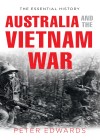Australia and the Vietnam War
Written by: Peter Edwards
New South Publishing, 2014, 338pp,
ISBN: 9781742241678
Reviewed by: Wing Commander Mark Smith
The year 2015 saw a number of commemorations of significant military events culminating in the April commemoration of the centenary of the ANZAC landings at Gallipoli. The year 2015 was also the 200th anniversary of Wellington’s victory at the Battle of Waterloo. Lesser known, and largely overlooked by most Australians, were the 50th anniversaries of the deployments of two Australian battalions to ongoing actions in South-East Asia. In January 1965, the Australian government sent an infantry battalion to Borneo to support British efforts in Malaya against Indonesian incursions. Then, in April 1965, the government announced that the 1st Battalion, Royal Australian Regiment, would be deployed to South Vietnam. The events throughout South-East Asia over the 20 years leading up to these deployments and their subsequent conduct form the subject of Australia and the Vietnam War.
C.E.W. Bean’s Anzac to Amiens and Gavin Long’s The Six Years War were the single, stand-alone companion volumes to the Official Histories of Australia’s involvement in the First and Second World Wars respectively, of which the authors were the official historians and general editors. This tradition has continued with the release of Australia and the Vietnam War written by Peter Edwards, who was the official historian and general editor of the nine-volume series, The Official History of Australia’s Involvement in Southeast Asian Conflicts 1948–1975.
Australia and the Vietnam War gives the reader a concise and well- structured introduction to the complexity of decolonisation throughout South-East Asia following the Second World War and the influence of the Cold War on the region, particularly the spread of communism, both real and threatened. During this period, the respective Australian governments were developing more independent foreign and defence policies that were inextricably linked to and influenced by events in the region. For a large portion of the period, the Australian government was dealing with two major powers, the United Kingdom and the United States of America, and their disparate views of regional stability pushed Australia into participating in two distinct conflicts simultaneously. While the focus of the book is the Vietnam War, it also covers the lesser know Malayan Emergency and the Confrontation with Indonesia.
Not being an actual volume of the Official History has allowed the author to examine the success of Australia’s foreign and defence policies of the era with the last chapter answering some questions posed in the preface. In particular the ‘domino theory’, the rationale underpinning allied intervention in the region, is examined to see whether it was a valid premise and how effective foreign intervention was in stabilising the region.
The author draws heavily on the nine volumes of the Official History as the primary source. This provides the reader with the references to delve further into particular aspects of the period.
I highly recommend Australia and the Vietnam War to any student of Australia’s foreign and defence policy post-Second World War. It should be essential reading for those beginning their journey into the history of Australia’s involvement in the Vietnam War.

